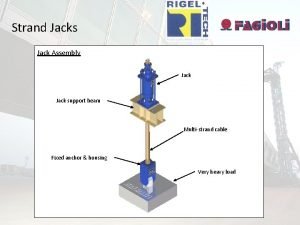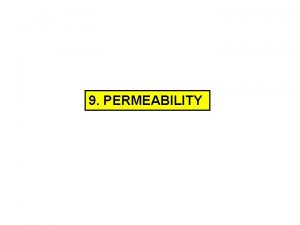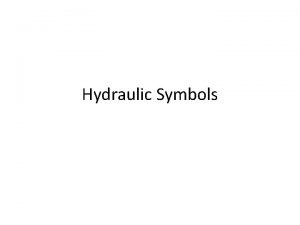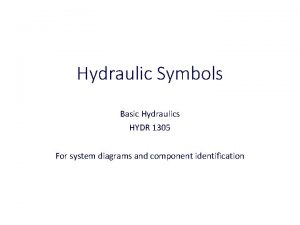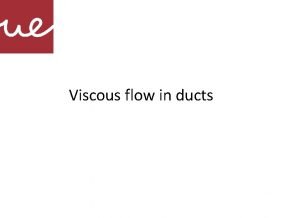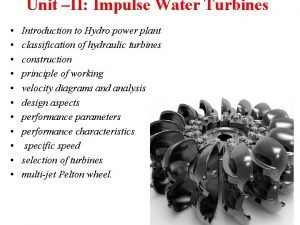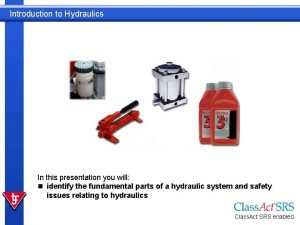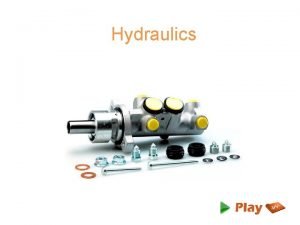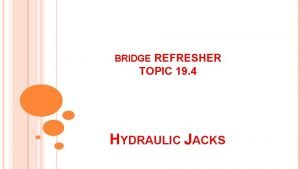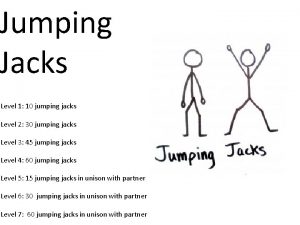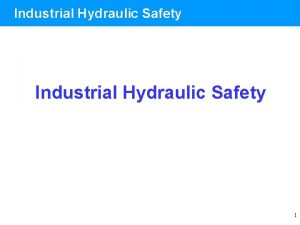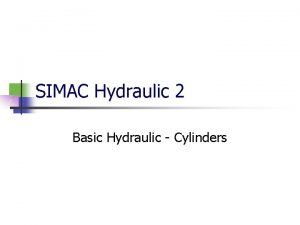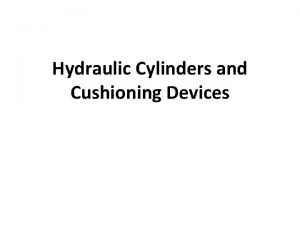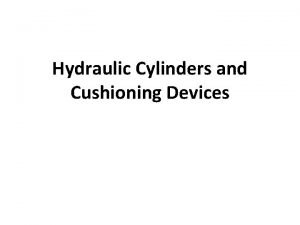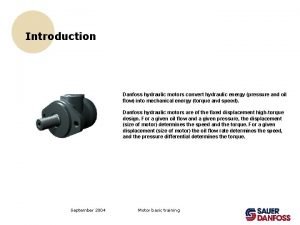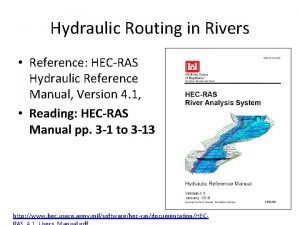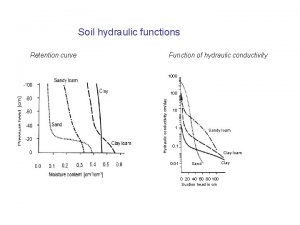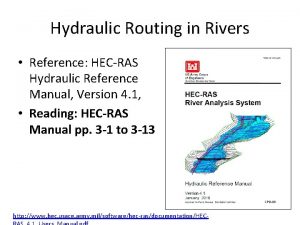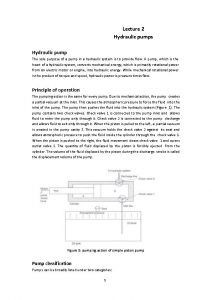PH IV 6 6 Hydraulic jacks case and











































- Slides: 43

PH IV 6. 6 Hydraulic jacks – case and maintenance screw jacks (Duff Norton types), traversing bases, use of derricks including erection, pulley block guy ropes, wire and manila ropes, use of different types of knots, max-pull arrangement (practical training) case of equipment.

ERECTION ACCESSORIES FOR BRIDGE GIRDERS

TYPES OF ACCESSORIES Jacks A jack is a mechanical lifting device used to apply great forces or lift heavy loads. A mechanical jack employs a screw thread for lifting heavy equipment. A hydraulic jack uses hydraulic power. Jacks are usually rated for a maximum lifting capacity (for example, 15 tons or 30 tons). Industrial jacks can be rated for many tons of load.

HYDRAULIC JACKS In 1838 William Joseph Curtis filed a British patent for a hydraulic jack. In 1851, inventor Richard Dudgeon was granted a patent for a "portable hydraulic press" - the hydraulic jack, a jack which proved to be vastly superior to the screw jacks in use at the time. Hydraulic jacks are typically used for shop work, rather than as an emergency jack to be carried with the vehicle usual care in selecting ground conditions, the jacking point on a vehicle, and to ensure stability when the jack is extended. A hydraulic jack uses a liquid, which is incompressible, that is forced into a cylinder by a pump plunger. Oil is used since it is self lubricating and stable. When the plunger pulls back, it draws oil out of the reservoir through a suction check valve into the pump chamber. When the plunger moves forward, it pushes the oil through a discharge check valve into the cylinder. The suction valve ball is within the chamber and opens with each draw of the plunger. The discharge valve ball is outside the chamber and opens when the oil is pushed into the cylinder. At this point the suction ball within the chamber

HYDRAULIC JACKS Types With Integrated Pump With Remote Pump Double Acting Jack Single Acting Jack

TYPES OF HYDRAULIC JACKS With Integrated Pump This Jack is having compact design with integrated pump makes it independent of external pumps and additional hoses.

TYPES OF HYDRAULIC JACKS With Remote Pump This Jack is required additional accessories Like remote pump, hose, coupler & Pressure gauge.

TYPES OF HYDRAULIC JACKS Single Acting Jack This Jack is lift/push by hydraulic pressure and its piston lowered/return back by gravity.

TYPES OF HYDRAULIC JACKS Double Acting Jack In this jack both lifting & lowering operations are by means of hydraulic pressure. This jacks are used both for pulling and pushing operation

TYPES OF HYDRAULIC JACKS Double Acting Jack In this jack both lifting & lowering operations are by means of hydraulic pressure. This jacks are used both for pulling and pushing operation

TYPES OF MECHANICAL JACKS Screw Jack, is a type of jack that is operated by turning a leadscrew. It is commonly used to lift moderately heavy weights, such as vehicles and as adjustable supports for heavy loads, such as bridge girders.

TYPES OF MECHANICAL JACKS Duff Norton type jack (Bottle Jack)

TYPES OF MECHANICAL JACKS Track Lifting Jack These are the simplest and sturdiest type of jacks for rough use. They are ideally suited for Railway track work, lifting and leveling of heavy machinery etc, for almost ground level in ship yards, industrial establishments, mills & mines. These Jacks are also provided with foot lifting arrangement.

TRAVERSING BASES This accessories are used for simultaneous operation lifting and side slewing In this system two jacking operations are involved one is in vertical direction and another is in horizontal direction. In the event of derailments, the traversing unit is used to raise rail vehicles, move them across the rails, thus allowing the vehicles to be rerailed. This is available in hydraulic as well as mechanical system

PULLEY BLOCKS Pulley is a simple machine and comprises of a wheel on a fixed axle, with a groove along the edges to guide a rope or cable. Pulleys are used to reduce the time and energy taken to lift heavy objects. Types Fixed Pulley (Upper block as shown in the sketch) It doesn’t run with load. Movable Pulley (Lower block as shown in the sketch) It moves with the load.


ROPES, KNOTS, SLINGS

ROPES Commonly used tool available in wide variety in form of synthetic and natural fibre materials, used for many applications in daily hoisting, rigging operations and : Slings for hoisting materials Handlines for lifting light loads Taglines for helping to guide and control loads It is a group of yarns, plies, or strands that are twisted or braided or together into a large and stronger form. It has tensile strength so being used as an dragging & lifting medium, in field of engineering. It is too flexible to provide compressive strength. As a result, they cannot be used for pushing or similar compressive applications. It is thicker and stronger than similarly constructed cord, line, string, and twine. Natural ropes to be used cautiously for rigging as their strength varies but deteriorates from rot, mildew and chemicals than that of synthetic fibre ropes.

FIBRE ROPES SIZE OF ROPE : Specified by its circumference not by its diameter e. g 25 mm rope or 75 mm rope. TYPE OF ROPES : 1. CORDAGE: Rope of fibrous materials like Jute, Putson and coconut fibre etc. Further classified depending upon the material used & subdivided into individual parts: Fibre : Individual fibres in the cordage. Yarn : A group of fibres. Strand : Three yarns make one strand. Rope : Three strands or more makes a rope. 2. STEEL WIRE ROPE : Rope made from metal strands. TYPE OF CORDAGE (Depending upon the material) : Manila Rope: Manufactured from outer fibre of the leaves of Banana plant exported from the city of Manila (Philipines).

ROPES Good type of cordage but not easily available in India. Depending upon quality & strength further divided as � Grade I : Black twisted threads in three strands. � Grade II : Black twisted threads inserted in two strands � Grade III: Black twisted threads inserted in one strand Hemp Rope : Stronger than Manila when kept in dry but costlier and not available easily. Sisal Rope : Commonly used in field and equivalent to grade III of Hemp. Coir Rope : Not used in field but has a great advantage over others where it comes in contact with water. Manufactured in Kerela. Cotton Rope : Are very strong but easily affected by weather conditions & normally used for erection of tents etc. Spun Yarn Rope : Are used for tying bundles & bags

ROPES Synthetic ropes are : Nylon Rope : Very strong, fine and smooth but nylon stretches so not used for rigging but can be used for towing gliders etc. These ropes are very expensive, loses strength when wet and low resistance to acids. Polyester Rope : Stronger then Polypropylene but not so strong as nylon. It has good resistance to acids / alkalis & do not stretch as much as nylon & don’t soften in heat Polypropylene : Most common fibre rope used in rigging. It floats but does not absorb water, stretches less then other fibres like nylon. It softens with heat so not used where work involving exposure to high heat. Fibre ropes conduct electricity when wet. When dry, however, polypropylene and polyester have much better insulating properties than nylon

ROPES Sizes and Lengths available : Ropes are generally available in bundles in following sizes and lengths Cordage Length 250 M Size Upto 150 mm Steel Wire Rope Length Size 1000 M 0 mm to 75 mm Steel Wire Rope : Parts (i) Wire - Equivalent to yarn in a cordage (ii) Strand - A group of wires make a strand (iii) Rope – A group of strands make a rope

ROPES Type of Wire Rope: They are classified into two types depending upon the flexibility to turn and bend. (i) Flexible S. W. R. – (called specially flexible S. W. R. ) (ii)Normal S. W. R. – (called general service S. W. R. ) Strength of the rope : Depends on its condition, material, method of manufacture and its age For calculation of the strength - Cordage & S. W. R. ropes are divided in two groups (i) New (ii) Old

ROPES When doubt as to its category, it is advisable to classify into latter type P = K 1 C 2 P = Allowable strength of the rope in cwts C = Size of the rope (circumference) in inches K 1 = A constant depending upon the material and condition as given in table SN 1 2 Type of Rope Cordage S. W. R. Condition Value of K 1 Value of P (a) Old 1 C 2 (b) New 2 2 C 2 (a) Old 9 9 C 2 (b) New 12 12 C 2 Remarks All these formulae will hold good only when the rope is without knots. Above formula gives the strength of the rope when used in a straight condition. If it is used in bends or around the pulleys, then strength of rope is decrease by following amount : (a) in sharp bends = 33% (b) when more then two turns (4 return) are given = 20%

ROPES Working Load Limit (WLL) Fibre Rope Selection Select size & Type of Rope on manufacturer’s information, conditions of use, the degree of risk to life and property. WLL of fibre rope is determined by multiplying the working load (WL) by Safety Factor (SF). Minimum breaking strength (MBS) is the force at which a new rope will break. Manufacturer’s DF (Design Factor) provides layer of safety determined by him. SF is greater than DF which adds an additional layer of safety to meet the requirement of users and regulators Together these added layer of safety provides protection above the MBS to account for reduced capacity due to :

ROPES Wear, broken fibres, broken yarns, age Ø Variations in construction size and quality Ø Shock loads Ø Minor inaccuracies in load weight calculations Ø Variances in strength caused by wetness, mildew & degradation Ø Yarns weakened by ground-in or other abrasive contaminants Ø Calculate the WLL of a rope to lift a WL of 250 pounds Note : Section 172 (1) (D) OF Construction Regulation requires a SF of 5. For more critical lifts that could risk life, limb or property a SF of 10 to 15 may be necessary. WLL = 250 pounds (WL) x 5 (SF) = 1, 250 pounds To meet the WLL you must use a rope with an MBS of 1, 250 to host or lower a WL of 250 pounds. Ø

ROPES Inspection On regular basis before use rope is to be inspected. Capacity to be based on the portion of rope showing most deterioration External wear and cuts, variation in size and shape of strands, discolouration and elasticity / life remaining Untwist the strands without kinking or distorting. Inside rope should be bright & clean as when it was new. Check for broken yarns, loose strands and yarns or accumulation of powdery dust, which indicates excessive internal wear between strands as the rope is flexed back and forth in use. Inside of rope is dirty and strands have started to unlay or if the rope has lost life and elasticity do not use it for hoisting.

ROPES Care of Ropes : (i) End of a cordage should be bound with twine or spun yarn so as to prevent untwisting and process known as whipping (ii) It should not be dragged in marshy soil and on gravel. Abrasive action will wear, cut and fill outside surface with grit. (iii) Let fibre ropes dry before storing them. Moisture hastens rot and causes rope to kink easily. Let a frozen rope thaw completely before you handle it or fibre can break. Let frozen rope dry naturally. (iv) It should be stored on dry platform and in coils well above the floor. Store fibre ropes in a dry cool room with good air circulation – Temp. 10 – 210 humidity 40 -60% (v) It should be properly wound before starting (vi) Protect fibre ropes from weather, dampness & sunlight. Keep away from exhaust gases, chemical fumes, boilers, radiators, steam pipes and other heat sources e. g near welding or flame cutting otherwise sparks and molten metal can cut the rope or set it on fire.

ROPES (vii) Kinks in a cordage if any to be removed immediately. In case to S. W. R. bends should also be removed. (viii) In case of S. W. R. if wire is broken it should be tucked in immediately (ix) A mixture of lamp black & raw linseed oil in equal quantities to be applied to wire ropes when not in use and to be lubricated by grease when running (x) Wire ropes not to be worked around a sheave or drum having lesser dimension than 10 times its dia (for flexible wire ropes 6 times the dia) (xi) Wash dirty ropes in clean cool water and hang to dry (xii) Sling angles must be ˃ 450. Lower angles increases load on each leg which is true with wire rope slings also. (xiii) Ensure fibre rope used with tackle is the right size for the sheaves having dia. At least six – preferably ten – times greater than the rope diameter.

KNOTS Knowledge of the varies types of knots is a pre-requisite for the Erector or it may cause loss of life of many. More than 100 different ropes knots, bends and hitches. Knot: - It is the intertwining of the end of a rope with a portion of rope. Bend: - It is the intertwining of the end of two ropes to make one continuous rope. Hitch: - It is the attachment of the rope to a post, pole ring, hook or other object. Splice: - It is the joining of the ends of two ropes or of the end of a rope with body of the rope by weaving the strands over and under the strands of the other part. General: Right sequence is essential in tying knots and are equally important in the direction the end is to take place whether it goes over, under or round other part of the rope. Otherwise as entirely different knot – or no knot at all will result.

KNOTS AND LASHINGS While tying a knot, to avoid it from slipping, two parts of rope to be squeezed together, in such a way to have a tendency to pull in opposite direction. Once knot are tied, they should be drawn up slowly and carefully to make sure that sections tighten evenly and stay in proper position. Knots, bends and hitches reduce rope strength. This depends on the knot and how it is applied. Use a spliced end with a hook or other standard rigging hardware such as slings and shackles to attach ropes to loads. Try to avoid tying knots in a rope.






SLINGS SLINGS: A flexible strap or belt used in the form of a loop to support or raise a hanging weight. Slings are often severely worn and used in harmful way in the construction so damage to it is caused by: Ø Failure to provide blocking or softeners between slings and load so allowing sharp edges or corners of the load to cut or abrade (wear away by friction) the slings. Ø Pulling slings out from under loads leading to abrasion (process of wearing) and kinking (sharp twist or curve) Ø Increasing the stress on sling or may be overloaded. Ø Traffic running over sling particularly tracked equipment. Errors in calculating loads and estimating sling angles hence WLL be based on a DF of atleast 5: 1 So, slings must be carefully inspected before use.

SLINGS Sling Angles: The rated capacity of sling depends on its size, its configuration and the angles formed by its legs with the horizontal. As the angle goes down, the load of each leg goes up, so keep sling angles greater than 450 whenever possible. The angle lower than 300 extremely hazardous. Sling Configurations: Slings are made up of various material such as Wire rope and Nylon web with various configurations for different purpose. Slings covers a wide variety of configurations for fibre ropes, wire ropes, chains and web.

SLINGS Single vertical Hitch: - Supports a load by single vertical part or leg of the sling. The total weight of the load is carried by a single leg. The sling angle is 900 from the horizontal and weight of the load can equal the WLL of the sling and fitting. Thimbles to be used in the eyes. This must not be used for lifting loose material, lengthy material or anything difficult to balance. Bridle Hitch: - Two, three or four single hitches can be used together to form a bridle hitch for hoisting an object with lifting lugs or attachments used with a wide assortment of end fittings. Provide excellent load stability when the load distributed equally among the legs. The hook is directly over the load’s centre of gravity.

SLINGS Adjust leg length with turn buckles to distribute the load equally. Sling angle be measured carefully to ensure individual legs are not overloaded. Single Basket hitch: - To support a load by attaching one end of the sling to the hook, then passing the other end under the load and attaching it to the hook. Ensure load does not turn or slide along the rope during a lift. Double Basket hitch: - Consists of two single basket hitches placed under the load. On smooth surface the legs will tend to draw together as the load is lifted. TO counter this brace the hitch against a change in contour or by other means to prevent from slipping.

SLINGS Keep legs apart to provide balance, but not below 600 from the horizontal. On smooth surfaces, this hitch is a better choice. Double wrap basket hitch: - Wrapped completely around the load & compressing it rather then supporting it. This can be used in pairs like double basket hitch. Excellent method for handling loose material, pipe, rod or smooth cylindrical loads because sling is in full 3600 contact with the load and tents to draw it together. Single choker hitch: - Forms a noose in the rope. Does not provide 3600 contact with the load. Not used to lift loads difficult to balance or loosely bundled. Useful for turning loads & for resisting a load that wants to turn. Chokers do not provide full support for loose loads material can fall. Not recommended when loads are long or loose bundles.

SLINGS Choker with two legs provides stability for longer loads. This configuration does not completely grip the load. Lift the load horizontally with slings of even length to prevent the load from sliding out. Lift loosely – bundled loads with a double wrap choker hitch. Double wrap choker hitch: - Formed by wrapping the sling completely around the load and hooking it into the vertical part of the sling. This hitch is in full 3600 contact with the load and bends to draw it tightly together. It can be used either singly on short, easily balanced loads or in pairs on longer loads.

SLINGS Endless slings or Grommet slings: - Useful for a variety of applications. This are manufactured by attaching the ends of a length of chain with a welded or mechanical link. Is made from one continuous strand wrapped onto itself to form a six-strand rope with a strand core. The end tucked into the body at the point where the strand was first laid into itself. Used for number of configurations, as vertical hitches, basket hitches, choker hitches basic and combinations of these basic arrangements. They are flexible but tent to wear more rapidly than other slings. Ensure that the splice is always clear of the hooks and load.
 Best worst and average case
Best worst and average case Myjacks card
Myjacks card Angela b. pan
Angela b. pan Jacks gully tip
Jacks gully tip Dorothy jacks cfa aas
Dorothy jacks cfa aas Multi strand jack
Multi strand jack Resume workshop presentation
Resume workshop presentation Jacks planner nau
Jacks planner nau J london menu
J london menu Stranger things giantess
Stranger things giantess Short case vs long case
Short case vs long case Binary search big o
Binary search big o Bubble sort best case and worst case
Bubble sort best case and worst case Bubble sort best case and worst case
Bubble sort best case and worst case Bubble sort best case and worst case
Bubble sort best case and worst case Cases of law of sines
Cases of law of sines Darcy law
Darcy law Spears and associates oilfield market report
Spears and associates oilfield market report Pneumatics and hydraulics basics
Pneumatics and hydraulics basics Hydraulic conductivity to permeability
Hydraulic conductivity to permeability Hydrologic routing and hydraulic routing
Hydrologic routing and hydraulic routing Clamp and drill hydraulic circuit
Clamp and drill hydraulic circuit Advantages and disadvantages of hydraulic actuators
Advantages and disadvantages of hydraulic actuators Differentiate between fat lime and hydraulic lime
Differentiate between fat lime and hydraulic lime Unidirectional pump symbol
Unidirectional pump symbol Regulator symbol
Regulator symbol Glennan building cwru
Glennan building cwru Fbi virtual case file case study
Fbi virtual case file case study Froude's number
Froude's number Hydrodynamic entry length formula
Hydrodynamic entry length formula Hydraulic fluid conditioning
Hydraulic fluid conditioning Impulse and reaction turbine difference
Impulse and reaction turbine difference Hydraulic engineering
Hydraulic engineering Total head equation
Total head equation Hydraulic pump construction
Hydraulic pump construction Pneumatic circuit double acting cylinder
Pneumatic circuit double acting cylinder Parker metamora ohio
Parker metamora ohio Aircraft hydraulic system
Aircraft hydraulic system Introduction to hydraulics and pneumatics
Introduction to hydraulics and pneumatics Hydraulic system components
Hydraulic system components Define hydraulic machine
Define hydraulic machine Fire sprinkler hydraulic calculation example
Fire sprinkler hydraulic calculation example Hydraulic engineering
Hydraulic engineering Mil-h-7644 color
Mil-h-7644 color





